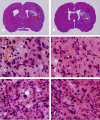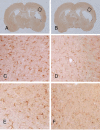NNZ-2566 treatment inhibits neuroinflammation and pro-inflammatory cytokine expression induced by experimental penetrating ballistic-like brain injury in rats
- PMID: 19656406
- PMCID: PMC2731085
- DOI: 10.1186/1742-2094-6-19
NNZ-2566 treatment inhibits neuroinflammation and pro-inflammatory cytokine expression induced by experimental penetrating ballistic-like brain injury in rats
Abstract
Background: Inflammatory cytokines play a crucial role in the pathophysiology of traumatic brain injury (TBI), exerting either deleterious effects on the progression of tissue damage or beneficial roles during recovery and repair. NNZ-2566, a synthetic analogue of the neuroprotective tripeptide Glypromate, has been shown to be neuroprotective in animal models of brain injury. The goal of this study was to determine the effects of NNZ-2566 on inflammatory cytokine expression and neuroinflammation induced by penetrating ballistic-like brain injury (PBBI) in rats.
Methods: NNZ-2566 or vehicle (saline) was administered intravenously as a bolus injection (10 mg/kg) at 30 min post-injury, immediately followed by a continuous infusion of NNZ-2566 (3 mg/kg/h), or equal volume of vehicle, for various durations. Inflammatory cytokine gene expression from the brain tissue of rats exposed to PBBI was evaluated using microarray, quantitative real time PCR (QRT-PCR), and enzyme-linked immunosorbent assay (ELISA) array. Histopathology of the injured brains was examined using hematoxylin and eosin (H&E) and immunocytochemistry of inflammatory cytokine IL-1beta.
Results: NNZ-2566 treatment significantly reduced injury-mediated up-regulation of IL-1beta, TNF-alpha, E-selectin and IL-6 mRNA during the acute injury phase. ELISA cytokine array showed that NZ-2566 treatment significantly reduced levels of the pro-inflammatory cytokines IL-1beta, TNF-alpha and IFN-gamma in the injured brain, but did not affect anti-inflammatory cytokine IL-6 levels.
Conclusion: Collectively, these results suggest that the neuroprotective effects of NNZ-2566 may, in part, be functionally attributed to the compound's ability to modulate expression of multiple neuroinflammatory mediators in the injured brain.
Figures





Similar articles
-
NNZ-2566, a glypromate analog, improves functional recovery and attenuates apoptosis and inflammation in a rat model of penetrating ballistic-type brain injury.J Neurotrauma. 2009 Jan;26(1):141-54. doi: 10.1089/neu.2008.0629. J Neurotrauma. 2009. PMID: 19119917
-
Mechanism of action for NNZ-2566 anti-inflammatory effects following PBBI involves upregulation of immunomodulator ATF3.Neuromolecular Med. 2013 Sep;15(3):504-14. doi: 10.1007/s12017-013-8236-z. Epub 2013 Jun 14. Neuromolecular Med. 2013. PMID: 23765588
-
Progesterone and allopregnanolone reduce inflammatory cytokines after traumatic brain injury.Exp Neurol. 2004 Oct;189(2):404-12. doi: 10.1016/j.expneurol.2004.06.008. Exp Neurol. 2004. PMID: 15380490
-
Neuroinflammation: beneficial and detrimental effects after traumatic brain injury.Inflammopharmacology. 2013 Aug;21(4):309-20. doi: 10.1007/s10787-012-0164-2. Epub 2013 Jan 8. Inflammopharmacology. 2013. PMID: 23296919 Review.
-
Neuroinflammation after traumatic brain injury: opportunities for therapeutic intervention.Brain Behav Immun. 2012 Nov;26(8):1191-201. doi: 10.1016/j.bbi.2012.06.008. Epub 2012 Jun 21. Brain Behav Immun. 2012. PMID: 22728326 Review.
Cited by
-
Trofinetide in Rett syndrome: A brief review of safety and efficacy.Intractable Rare Dis Res. 2023 Nov;12(4):262-266. doi: 10.5582/irdr.2023.01060. Intractable Rare Dis Res. 2023. PMID: 38024580 Free PMC article.
-
Traumatic brain injury using mouse models.Transl Stroke Res. 2014 Aug;5(4):454-71. doi: 10.1007/s12975-014-0327-0. Epub 2014 Feb 5. Transl Stroke Res. 2014. PMID: 24493632 Review.
-
An update on diagnostic and prognostic biomarkers for traumatic brain injury.Expert Rev Mol Diagn. 2018 Feb;18(2):165-180. doi: 10.1080/14737159.2018.1428089. Epub 2018 Jan 23. Expert Rev Mol Diagn. 2018. PMID: 29338452 Free PMC article. Review.
-
Is trofinetide a future treatment for Rett syndrome? A comprehensive systematic review and meta-analysis of randomized controlled trials.BMC Med. 2024 Jul 18;22(1):299. doi: 10.1186/s12916-024-03506-9. BMC Med. 2024. PMID: 39020317 Free PMC article.
-
Interferon-Gamma and Interleukin-1Beta Enhance the Secretion of Brain-Derived Neurotrophic Factor and Promotes the Survival of Cortical Neurons in Brain Injury.Neurosci Insights. 2020 Jul 29;15:2633105520947081. doi: 10.1177/2633105520947081. eCollection 2020. Neurosci Insights. 2020. PMID: 32776009 Free PMC article.
References
-
- Langlois JAR-BW, Thomas KE. Traumatic Brain Injury in the United States: Emergency Department Visits, Hospitalizations, and Deaths. Atlanta, (GA): Centers for Disease Control and Prevention, National Center for Injury Prevention and Control; 2006.
-
- Thurman DJAC, Browne D, Dunn KA, Guerroro J, Johnson R, Johnson V, Langlois J, Pilkey D, Sniezek JE, Toal S. Traumatic Brain Injury in the United States: A Report to Congress. Atlanta, (GA) Centers for Disease Control and Prevention; 1999.
Publication types
MeSH terms
Substances
LinkOut - more resources
Full Text Sources
Other Literature Sources
Medical

